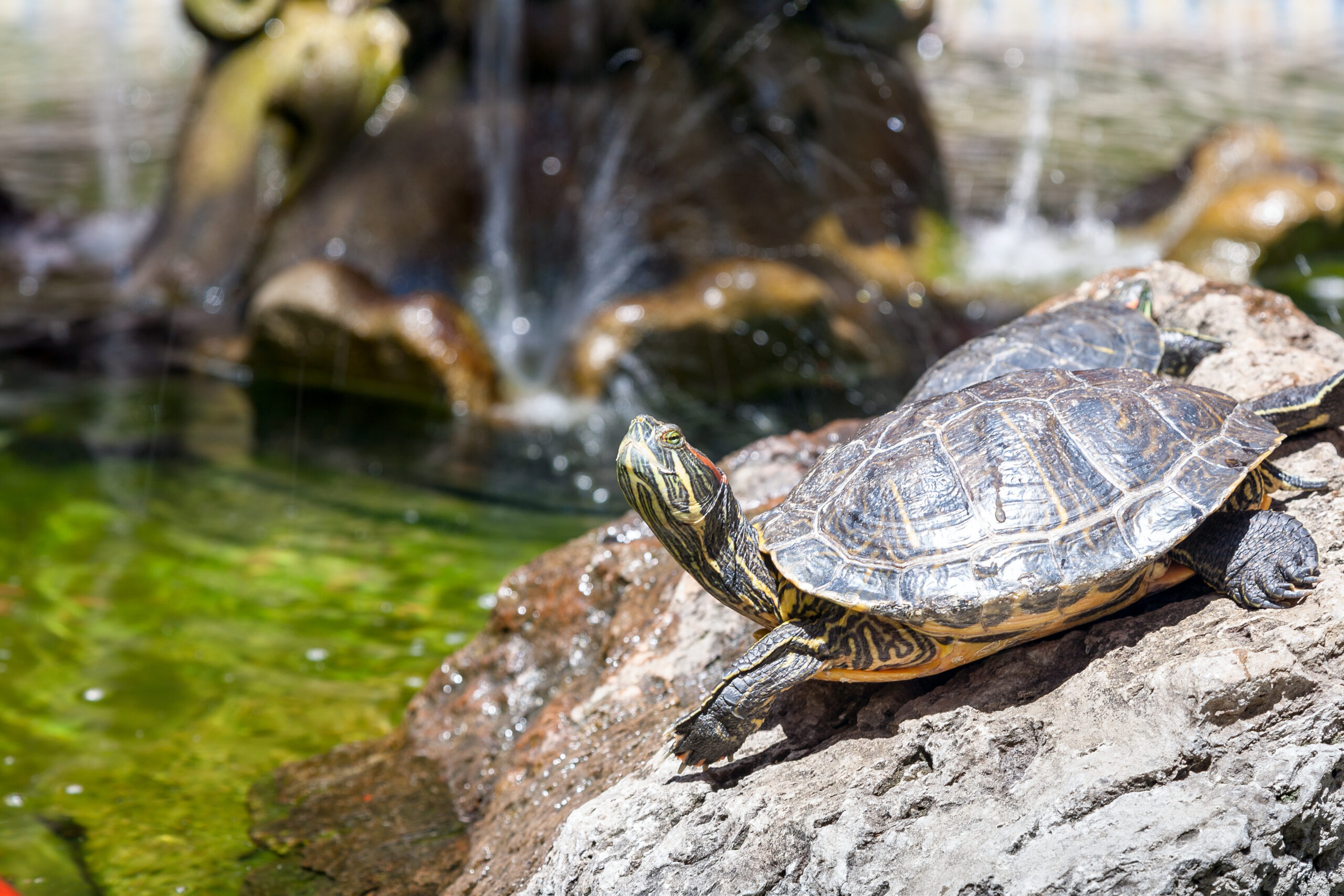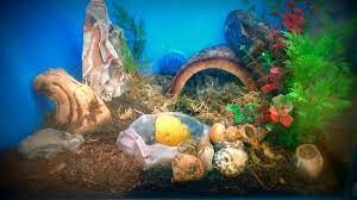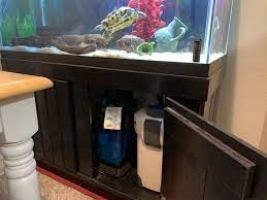Turtle
4 types of domestic turtles to have at home?

Domestic turtles are differentiated into water turtles and land turtles. As their names indicate, the former need a pond or an aquarium to survive and the latter, a terrarium as large as possible where they can carry out their daily activities. Within each category there are different types, so it is important to be well informed about their care before adopting or buying a specific one.
As a general rule, these animals do not demand too much attention, although it must be taken into account that they have some special needs compared to other pets. Turtles are a very interesting species, especially because of their anatomy made up of a hard shell that serves as protection in case they feel any threat, since their slow movements prevent them from running to escape. On the other hand, they are also quite similar to other reptiles in that they are cold-blooded animals that need to be in warm environments.
Which domestic turtle to choose?

https://www.hospitalveterinariglories.com/types-domestic-turtles/?lang=en
- Florida Box Turtle – The Carolina terrapene has a shell that allows it to hide completely. The particular design of its casing gives it superior protection in case of encountering a predator. It is a small turtle that, at most, can reach 15 centimeters. During its 80-year life expectancy, it needs an outdoor space, although it can also be in an aquarium. It is very important that the ambient temperature where this turtle is found is above 15 degrees throughout the day and has a certain level of humidity to prevent the eyes and respiratory tract from drying out. Regarding its diet, it is very important to provide it with fresh and clean water daily, as well as insects, vegetables, fruits, etc.
- Red-eared slider turtle : it is a type of water turtle that is also called the Florida slider. Its name is due to the two red stripes on the sides of its head. They can reach 30 centimeters in length, although if it is a female it is likely that it will exceed this size. Normally, these turtles live up to 40 years and the aquatic environment is essential for their survival, along with a humid and sunny habitat. During the winter, it is most common to find it hibernating at the bottom of the pond or aquarium. Special care should be taken with the spread of salmonella to children.
- Woodland Tortoise – It is easy to tell this type of tortoise apart by its dark gray shell and orange body with black flecks. Another peculiarity of this species is that during the coldest months it chooses the water to hibernate , but when the good weather arrives they seek to move on land. Contrary to what happens in other cases, male forest turtles are usually larger than females, reaching around 23 centimeters and approximately one kilo in weight.
- Russian tortoise : within domestic tortoises, this is one of the most common that is usually kept in homes. Its carcass is light in color with dark spots in the form of squares. In freedom, this tortoise usually lives 40 years , although as a pet it can become a century-old animal. They are characterized by having an infallible sight that even allows them to recognize people, as well as a highly developed sense of smell and a high sensitivity to ground vibrations. It is important for the Russian Tortoise to live in a spacious outdoor aquarium to enjoy the warmth of the sun, but it also resists temperatures below 15 degrees and reduced humidity levels quite well. It is very important that the ambient temperature where this turtle is found is above 15 degrees throughout the day and has a certain level of humidity to prevent the turtle.

Turtle
Discovering the Enchantment of Turtle Back Zoo

Turtle Back Zoo stands as a testament to the beauty and diversity of the natural world. Since its inception, this beloved zoo has captivated visitors with its commitment to conservation, education, and providing a home to a fascinating array of animal species. Let’s embark on a virtual journey to uncover the magic of Turtle Back Zoo.
History and Evolution
The roots of Turtle Back Zoo trace back to the early 20th century, evolving from a reptile collection in the late 1950s to the accredited zoological park it is today. Named after the nearby Turtle Back Rock, the zoo has undergone significant transformations, expanding its exhibits and facilities while prioritizing the welfare of its inhabitants.
Exhibits and Wildlife Encounters
From the majestic big cats to the playful penguins, Turtle Back Zoo offers an immersive experience for visitors of all ages. Visitors can wander through diverse habitats such as the African Adventure, where giraffes gracefully roam, or the Tropical Currents Aquarium, teeming with aquatic wonders from around the globe.
The zoo’s emphasis on conservation is evident in its efforts to house endangered species and educate the public about their plight. Encounters with Amur leopards, red pandas, and snow leopards highlight the critical need for wildlife preservation.
Educational Initiatives and Outreach
Education lies at the heart of Turtle Back Zoo’s mission. Through interactive programs, guided tours, and informative exhibits, the zoo aims to inspire a deeper appreciation for wildlife and promote conservation efforts. Schools and groups often participate in specially tailored programs that provide insights into animal behavior, habitat conservation, and environmental stewardship.
Conservation Efforts and Sustainability
Beyond its role as a recreational space, Turtle Back Zoo actively contributes to global conservation efforts. Collaborating with various organizations, the zoo participates in breeding programs for endangered species, conducts research, and supports initiatives aimed at protecting natural habitats. Additionally, the zoo prioritizes sustainable practices, implementing eco-friendly measures to reduce its environmental footprint.
Community Engagement and Events
The zoo serves as a hub for community engagement, hosting events, workshops, and seasonal celebrations. From summer concerts to Boo at the Zoo during Halloween, these events offer families a chance to connect with nature while enjoying entertaining activities. Community partnerships also play a crucial role, fostering a sense of shared responsibility for wildlife preservation.
Future Endeavors and Expansion
Looking ahead, Turtle Back Zoo continues to evolve, with plans for further expansion and enhancement of exhibits. The zoo aims to introduce new species, upgrade facilities to provide enhanced habitats, and implement cutting-edge technologies for both animal care and visitor experience.
Conclusion
Turtle Back Zoo stands as a testament to the wonders of the animal kingdom and the importance of conservation. With its dedication to education, conservation, and providing a safe haven for wildlife, this New Jersey gem offers visitors a glimpse into the beauty and diversity of our natural world while emphasizing the need for collective action in preserving it for generations to come. Whether you’re a wildlife enthusiast, a family seeking adventure, or someone passionate about conservation, Turtle Back Zoo offers a captivating experience that inspires, educates, and fosters a deeper connection to our planet’s remarkable biodiversity.
Turtle
PetSmart Crabs – The Right Way to Care For Your Pet Crabs

There are a number of things that you should keep in mind when you are looking for PetSmart crabs to purchase for your pet. Some of these factors include their cost, how long they will live for, and how to care for them. Also, you should consider the type of tank that you will use for them.
Life expectancy
When it comes to hermit crabs, PetSmart is probably the first place you think of. They are relatively inexpensive and can be fun to keep. If you want to find a store near you, you can check out their website.
Although the company has an online presence, you can usually get a good deal by visiting a local brick and mortar store. You can also take a look at their website to see if they have any special deals going on.
There are several things to consider before deciding which hermit crab to purchase. The life expectancy of your pet depends on how well you care for it. For example, a hermit crab’s life span will depend on how well you maintain its terrarium. It also requires proper ventilation, humidity, and fresh water.
Other considerations include the size of the tank you choose. The size of the tank is largely determined by how many crabs you wish to house. For instance, a 10-gallon tank will fit a couple of males and one or two females. However, a larger tank may be a better option if your crabs are aggressive.
Feeding habits
If you’re looking to buy your first pet, chances are you’ve done your research. You may have even consulted with an employee at your local pet store. They are supposed to be the role models for responsible pet care. However, what is the right way to treat your petsmart hermit crab?
There are a few tricks of the trade to keep your hermit happy and healthy. The most important is creating a home environment that will make them feel safe and secure. This means providing them with a suitable habitat with plenty of room to explore.
One of the best ways to do this is to provide them with an adequate supply of fresh water. Water temperature and salinity should be adjusted to suit your crab’s needs. Make sure to also feed your hermit a variety of fresh fruits, veggies, and grains.
Another way to ensure your pet is in good health is to provide it with a well-lit environment. While you may not want to put your hermit under the spotlight, a little natural lighting can go a long way towards ensuring your pet’s well being.
Cost of a crab tank
Red Claw Crabs are relatively easy pets to keep for beginners. They require an aquarium tank with a capacity of 10 gallons. However, you’ll also need a reliable filtration system.
Purchasing a tank with a filtration system is a necessary component of red claw crab care. It helps to keep the salinity and pH levels in check, and can help prevent any toxicity in the water.
Red Claw Crabs are sensitive to the water they live in. If the conditions in the tank are poor, they will be stressed and may even become ill.
Crabs need a lot of room to move around and to molt. They should have a tank that is about 60 cm wide. This will allow them to move easily, but also give them enough space to burrow under the substrate.
Hermit crabs need plenty of water. You should change about 10 percent of the water in your tank every week.
Appropriate tank mates for a Vampire Crab
Vampire crabs are a great addition to your aquarium. They are small creatures that are easy to care for and can be very attractive. However, it is important to keep them in the right environment so that they can thrive.
If you are considering getting a vampire crab, it is essential to understand its unique requirements. For instance, they are very sensitive to changes in water quality and temperature. Therefore, you must keep them in a clean and well-maintained tank.
The ideal tank for vampire crabs should be about 10 gallons. This will give them plenty of space to move around. Also, they prefer to live in groups.
Aside from the tank, you should also add plenty of plants. These can be of several types. You may even want to add floating plants.
In order to keep a healthy tank, you should change 40% of the water in the tank every month. You can also add a humidifier to maintain the desired level of humidity.
Turtle
8 Best Filters For Turtle Tanks

- Canister filters: These filters are powerful and efficient, and are great for larger turtle tanks.
- Power filters: These filters are easy to install and maintain, and are suitable for smaller turtle tanks.
- Underwater filters: These filters are designed to be placed inside the tank, and are great for keeping the water clean and clear.
- Hang-on-back filters: These filters are easy to install and maintain, and are suitable for both small and large turtle tanks.
- Sponge filters: These filters are simple and efficient, and are great for keeping the water clean and clear.
- Box filters: These filters are great for larger turtle tanks, and are designed to be placed outside the tank.
- Bio-filters: These filters are designed to promote the growth of beneficial bacteria, which help to keep the water clean and clear.
- UV sterilizers: These filters use ultraviolet light to kill harmful bacteria and parasites, and are great for keeping the water clean and clear.
Aquatic Turtle Filters & Pumps
are simple and efficient, and are great for keeping the water clean and clear.
Pumps:
- Submersible pumps are designed to be placed inside the tank, and are used to circulate the water and increase oxygen levels.
- External pumps are designed to be placed outside the tank, and can be used in conjunction with a filter to increase water flow and oxygenation.
- Air pumps can be used to provide additional oxygen to the water, and can also be used to power undergravel filters or create a current in the tank.
It’s important to choose the right filter and pump for your turtle tank based on the size of the tank and the number of turtles, as well as the specific needs of the species of turtle you are keeping. It’s also important to regularly maintain and clean the filter and pump to ensure they continue to function properly.
Mechanical filtration: this type of filtration uses materials such as sponge or filter pads to physically remove debris and particulate matter from the water.
Biological filtration: this type of filtration uses materials such as bio-balls or ceramic noodles to promote the growth of beneficial bacteria that break down waste products and other contaminants.
Chemical filtration: this type of filtration uses activated carbon or other chemical media to remove dissolved impurities and odors from the water.
Some filters also include a UV sterilizer, which uses ultraviolet light to kill harmful bacteria and parasites in the water.
Overall, turtle filters help to maintain a healthy environment for the turtles by keeping the water clean, clear, and free of harmful contaminants. It’s important to choose the right filter for your turtle tank based on the size of the tank and the number of turtles, as well as the specific needs of the species of turtle you are keeping.
-

 Exotic1 year ago
Exotic1 year agoChoosing Koi Fish From Petsmart
-

 Dog2 years ago
Dog2 years agoPomeranian Dog Best Bread Information
-

 Turtle2 years ago
Turtle2 years ago8 Best Filters For Turtle Tanks
-

 Turtle2 years ago
Turtle2 years agoPetSmart Crabs – The Right Way to Care For Your Pet Crabs
-

 Exotic10 months ago
Exotic10 months agoBuying a Bearded Dragon For Sale From PetSmart? Read This First
-

 Login10 months ago
Login10 months agoanimal shelters near me
-

 CAT1 year ago
CAT1 year agoBuying a Whisker City Water Fountain
-

 Dog2 years ago
Dog2 years agoLarge Münsterländer And Its Breed In 2022